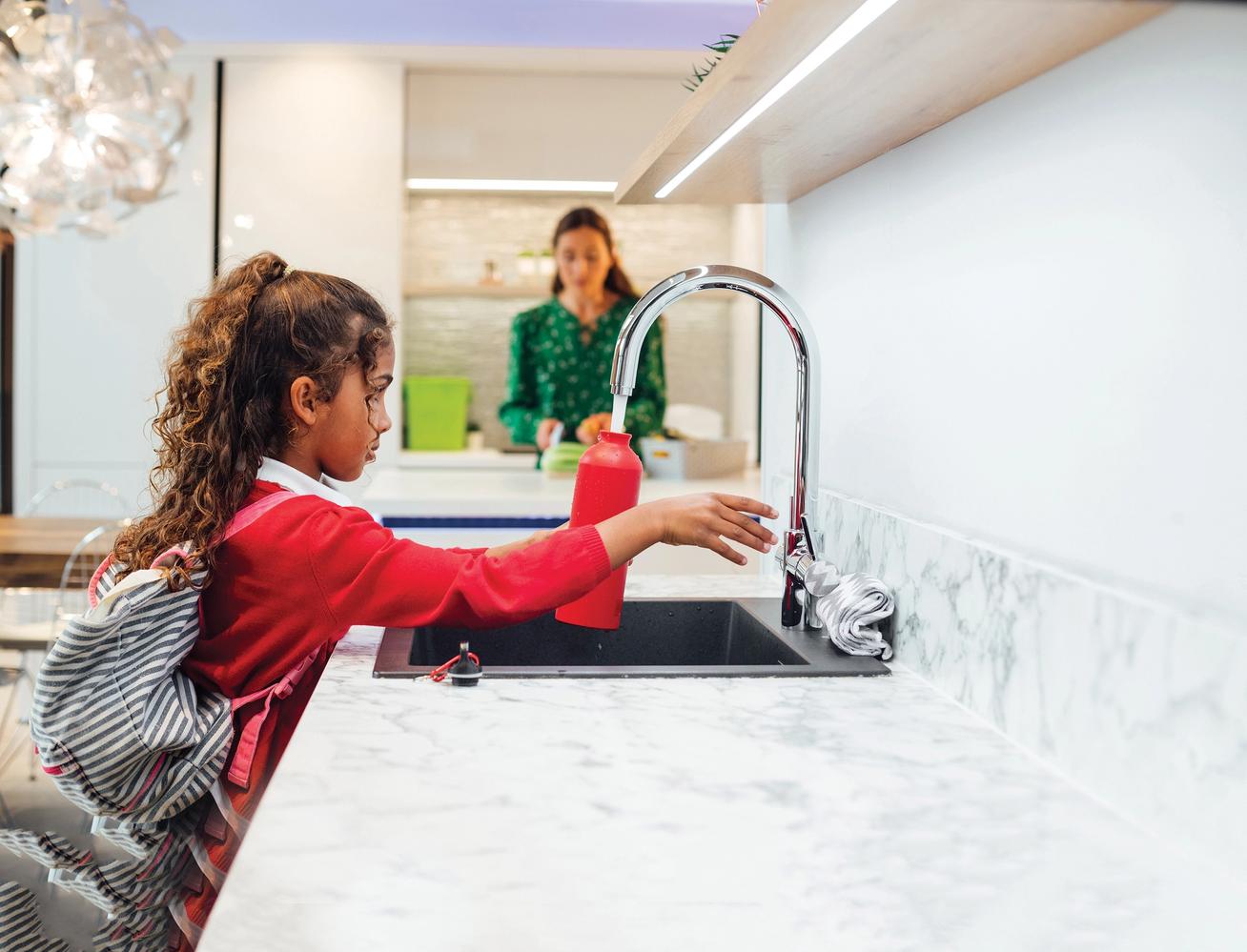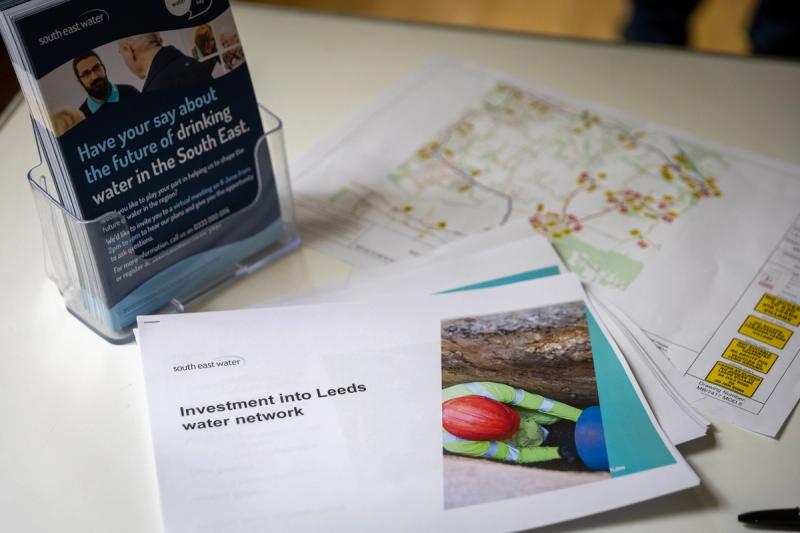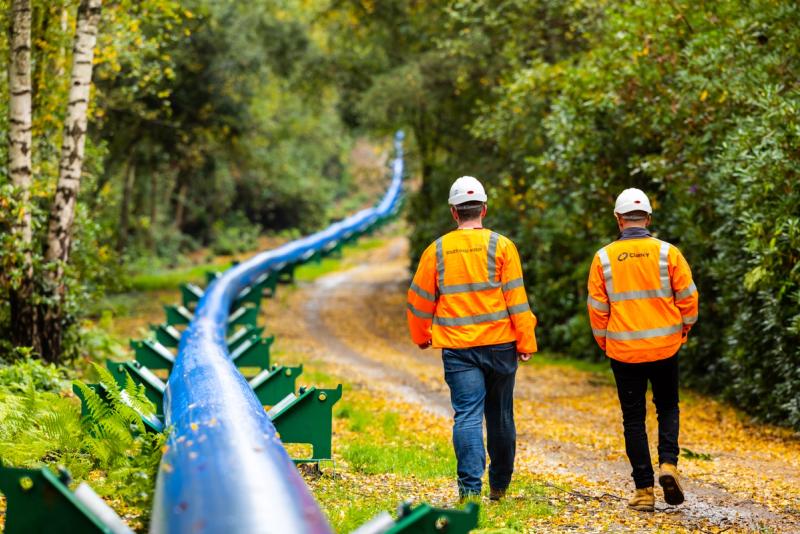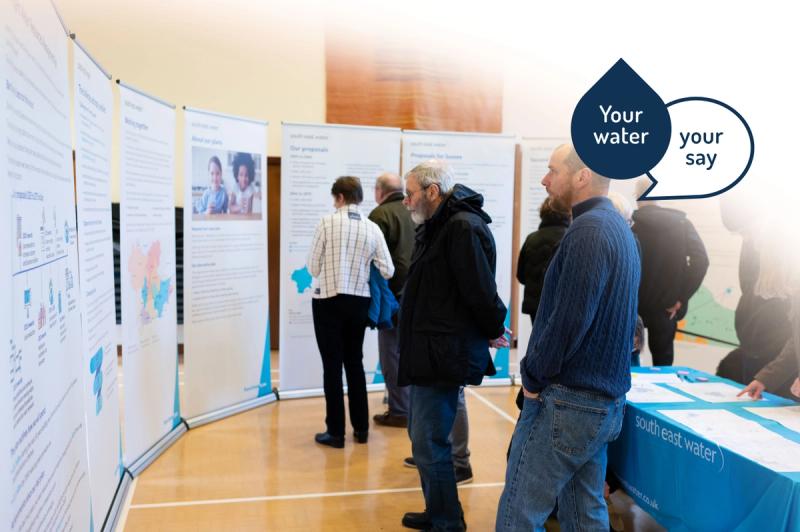We have submitted our most ambitious five-year plan ever to Ofwat with an investment into the infrastructure of £1.9 billion.
We recognise that our ability to supply customers during extreme weather events has been challenged, and we have not provided the service we should have done.
This plan addresses those issues head-on with a locally researched, representative, and cost-effective proposal that will make great strides towards providing you with the public water service you expect and deserve.
We have included in the plan a significant investment into the network to improve customer service, reduce customer supply interruptions and strengthen network resilience.


This level of investment will mean an increase in customer’s bills. While increasing bills is never welcome, investment in our water system is essential to ensure the security of our water supply in the future. Using the Ofwat investment methodology, we believe that delivery of this plan will see bills rise on average from £19.33 a month in 2025 to £23.12 a month by 2030.
The funds raised are guaranteed only to fund improvements in our water systems -and if these improvements aren’t delivered, bills will automatically be reduced.
We believe this is the right plan which will allow us to:
- Invest in providing new sustainable water resources for the regions, such as a new reservoir at Broad Oak, near Canterbury – which is planned for completion by 2033.
- Improve network resilience by making the most efficient connections in our networks to enable us to move water around more effectively. This will allow us to provide the public water service more efficiently in areas of recent challenge, such as near the end of networks.
- Increase the capacity of drinking water storage available in the right locations, to improve resilience and provide a greater buffer to reduce supply interruptions.
- Work with customers – both household and non-household to reduce the amount of water that is being used at home and in businesses. We will commence a smart meter roll out in this business cycle which will see 275,000 meters implemented, with the roll out completed by 2035.
- Implement a smart water network with a comprehensive roll out of additional meters, sensors, and loggers. This allows for dynamic management of the network to reduce leakage and improve resilience.
- Use other innovations to drive down leakage even further, reducing the amount of drinking water lost through leaks and burst mains. Historically, we have been one of the best performers in the water industry on reducing leaks, achieving our regulatory target in 14 of the last 15 years.
- Work with partners to improve the quality of raw water entering our catchments. We want to continue and enhance the work started in the last business plan to improve the quality of river water in our region.
- Build three new nitrate treatment plants to address increasing nutrient levels in the raw water, that will breach nitrate trigger levels before catchment solutions are able to mitigate and reverse the trends seen.
- Provide additional resources required to respond to unplanned supply interruptions, giving us more options to support all customers and return the mains supply.
- Continue to deliver excellent drinking water quality.
- And all of this will be achieved whilst ensuring that we tackle water poverty, increasing the support we give to vulnerable customers through a new six-point plan. We want to remove water poverty altogether by 2030.
How the plan was created
The plan was created using feedback from customers and stakeholders both regionally and locally, ensuring that the conversations we had directly reflect the service that customers experience. It has allowed us to create plans that meet those local needs.
We understand that customers in Kent and Sussex are more generally worried about how we are going to prevent supply interruptions, whilst in the Western region we have sought more views on local environmental challenges such as raw water quality or reducing the amount of water we extract from the environment. As a result, our investment plans reflect this local sentiment.
Our plan limits the impact on customer bills over this period by funding a significant proportion of the investment through raising capital from our lenders and shareholders.
We have tested both bill changes with customers and they produce similar acceptability and affordability results.
We are committed to ensuring that those customers who need support paying their bills can access help easily and have developed a six-point plan to address this.
Freqently asked questions
We’ve submitted our business plan proposal to our regulator, Ofwat which is our proposal of how we will provide the public water service from 2025 to 2030.
- Invest in a new reservoir at Broad Oak, near Canterbury – which is planned for completion by 2033.
- Improve network resilience by increasing network connections, meaning we can move water around our network more easily.
- Increase the capacity of drinking water storage tanks available in the right locations, across the network, to improve resilience and provide a greater buffer to reduce supply interruptions.
- Work with customers – both household and non-household to reduce the amount of water that is being used at home and in businesses.
- We will commence a smart meter roll out in this business cycle which will see 275,000 meters implemented, with the roll out completed by 2035.
- Implement a smart water network with a comprehensive roll out of additional meters, sensors, and loggers.This allows for dynamic management of the network to reduce leakage and improve resilience.
- Use other innovations to drive down leakage even further, reducing the amount of drinking water lost through leaks and burst mains.
- Work with partners to improve the quality of raw water entering our catchments. We want to continue and enhance the work started in the last business plan to improve the quality of river water in our region.
- Build three new nitrate treatment plants to address increasing nutrient levels in the raw water, that will breach nitrate trigger levels before catchment solutions are able to mitigate and reverse the trends seen.
- Provide additional resources required to respond to unplanned supply interruptions, giving us more options to support all customers and return the mains supply.
- Continue to deliver excellent drinking water quality.
- And all of this will be achieved whilst ensuring that we tackle water poverty, increasing the support we give to vulnerable customers through a variety of support measures. We want to remove water poverty altogether by 2030.
Using the Ofwat investment methodology, we believe that delivery of this plan will see bills rise on average from £19.33 a month in 2025 to £23.12 a month by 2030. This is an increase of £3.79 a month over the five-year period.
The plan will make great strides towards tackling the challenges we’ve faced in previous years. With a new reservoir, increased network connectivity, greater levels of drinking water storage, reductions reduce water usage and improvements to our local environment, we believe this plan is the best option we have to solve issues experienced in the last few years.
The challenges we face in our Hampshire, Berkshire and Surrey supply regions are different. In this area, we have a stable and well-connected network and good levels of water resources.
However, it faces its own challenges, such as the environment and the quality of raw water. Our business plan includes measures to tackle these issues, too.
We have created a 6-point plan to help customers who need additional support. This includes increasing the household income threshold by 17 per cent allowing more households to qualify for our social tariff, and a commitment to eradicate water poverty in our supply area by 2030.
No. The plan has been created on a regional basis to reflect the differing nature of the challenges faced in each of the regions, ensuring we target each region with the most appropriate solutions.
The support included in our enhanced 6-point plan will mean that those who are more financially fortunate supporting those who need that extra help. Through our research, customers responded positively to this.
Water poverty is defined by a household spending at least three per cent of household income on their water bill.
Our 6-point plan includes measures to introduce a new social tariff, increase targeting and awareness, working with partnership organisations to increase levels of engagement.
Auto enrolment data share agreements with local authorities will also see more customers automatically transferred onto social tariffs without having to apply, ensuring we are providing support to as many people who need it, as possible.
We do support this. CCW is calling for a national social tariff to ensure that no one must spend more than five per cent of their income on water costs. Our 6-point plan to eradicate water poverty by 2030 supports this.
The shareholders of South East Water have not taken a dividend since 2019 and do not intend to take a dividend for the remainder of this business cycle, which ends in 2025.
This investment plan is focused on tackling head on the unacceptable supply issues which have affected our customers, driven by accelerating climate change. In return for the investment made, our shareholders and other investors will expect a return, just like you and I would if we deposited money in the bank. Using Ofwat’s investment framework we ensure that any future shareholder returns are fair.
Between 2025 and 2030 we’re planning to replace 275,000 existing meters with smarter meters across our network. These meters will be able to measure water usage at regular intervals throughout the day and night, helping us tailor our customer experience. For example, if a customer is seen as using water constantly overnight, it’s probably a sign that they’ve got a hidden leak, this will flag on our systems enabling us to help them repair hidden leaks, reducing unnecessary water consumption.
These meters are not the same as the electricity and gas smart meters currently installed in homes, this is because the technology required for smart water meters is still under development.
No. Smart meters are an important tool for us to help reduce the amount of water that people use at home. They provide valuable help in identifying households with high levels of water usage and allow us to nudge behaviour change in a timelier way than our current meter network allows us to.
We have an ambitious plan to reduce the level of leakage by 50 per cent by 2050. Using a combination of new technologies and innovation, we aim to reduce leakage by 26 per cent during the next five years.
Unfortunately, running a water network means that there will always be leaks and bursts across our 9,000 miles of pipes from time to time. However, with the introduction of a smart water network, we are confident that we will be able to identify and fix leaks faster.
During the pandemic, we saw a significant change in the way in which customers use water. Pre-pandemic, many of our customers commuted into London.
With an increase in working from home, water usage at home has increased as more people are not commuting into London.
Our plans in PR19 didn’t envisage a global pandemic and shift in the way people work. This is reflected in our latest plans.
We have Capital Grants available for farmers in priority catchments which can be used fund water resilience projects, such as rainwater harvesting systems. More details can be found here
Within the business plan we have several measures to help reduce the amount of water our customers use at home.
From home visits, more water saving devices, greater awareness, and a schools education programme to the introduction of over 275,000 smarter meters, we have a lot of ways to help our customers to use less water.
The environment is integral to everything we do. We need to make sure that water supplies remain plentiful and sustainable in the long term, whilst not seeing a deterioration in the quality of raw water across our regions.
We’re working collaboratively with regional partners to achieve those goals and have developed an ambitious Water Industry National Environment Programme (WINEP 24), underpinned by our co-created 25 Year Environmental Plan (25YEP), where we seek to proactively address environmental challenges. This is an industry first and something that we’re extremely proud of.
We can’t guarantee that there will be no more hosepipe bans. The south east is an area of water stress, so it’s always a fine balancing act to maintain customer supply. However, this plan strives to increase the resilience in our network, which will reduce the likelihood of hosepipe bans in the future.
As a company, South East Water has owned the land at Broad Oak, near Canterbury, since the 1970s. Development of the reservoir has been included within previous business and Water Resources Management Plans s, but we’ve always been encouraged to work with customers to reduce the amount of water they use first, meaning that the investment has not been agreed. Through our latest Water Resources Management Plan, published this year, we now see this as the optimal solution for providing a long-term water resource in the east Kent area, with plans to have it operational by 2033.
Building a reservoir takes a considerable amount of time, and we’ve already brought forward the opening date from 2036 to 2033. There is a long planning process to undertake before we can start construction, and then once built we estimate that the reservoir will take up to two years to fill.
At this stage there are no plans for desalination plants in our current business plan. We do not rule out introducing desalination plants in the future but are conscious of their carbon footprint. We believe there are other ways in which we can provide the future water supply, which is included in this plan.
At South East Water we must play our part in tackling climate change and this plan includes commitments to reduce the level of greenhouse gas emissions we emit. And as much as we understand the importance of network resilience, we need to build environmental resilience too.
Our plan addresses the future challenges expected through drought, flooding, raw water quality decline, impact from Invasive Non-Native Species (INNS) and land use change. Put simply, we aspire to leave the environment in a better place for future generations.
The environment is integral to everything we do. We need to make sure that water supplies remain plentiful and sustainable in the long term, whilst not seeing a deterioration in the quality of raw water across our regions.
We also need to maintain and improve the quality of water in specific catchments to ensure that we have enough water for the future and support the environment that depends on it.
The Water Industry Act states that water companies must always provide new water connections for domestic purposes. Developers help to fund new developments and work with us to ensure that existing customers are not impacted by the additional draw on our network. We are not able to limit housebuilding.
We have a company emergency plan which complies with statutory requirements and clearly outlines the processes we must take when there is an incident. Recent incidents have had far greater customer impact than what we are legally required to plan for, and the business plan explains we will be updating our emergency plan accordingly. We have already put in new procedures and systems in place to improve our response and are seeing positive results.
When things do go wrong, we operate by our Guaranteed Standards of Service (GSS) which sets out how we will compensate customers. Details of our GSS are on our website. A key objective of this plan is to make our network more resilient and reduce the times when customers have their water supplies interrupted.
Technical documents
Appendices
- Cost adjustment claim(opens in a new tab)
- Cost assessment(opens in a new tab)
- Current performance (opens in a new tab)
- Data Strategy (opens in a new tab)
- Direct procurement for customers (opens in a new tab)
- Engaging with customers, communities and Stakeholders (opens in a new tab)
- Environment(opens in a new tab)
- Finance (opens in a new tab)
- Governance and assurance (opens in a new tab)
- Investment overview (opens in a new tab)
- Markets and growth (opens in a new tab)
- Performance commitments and outcomes delivery incentives(opens in a new tab)
- PR24 Affordability and Vulnerability (opens in a new tab)
- PR24 Engagement synthesis report (opens in a new tab)
- Price Control Deliverables (opens in a new tab)
- Resilience (opens in a new tab)
- Retail appendix (opens in a new tab)
- SEW Chlorate Estimate (opens in a new tab)
- SEW PFAS options(opens in a new tab)
- SEW Resillience Optimisation (opens in a new tab)
- Water efficiency and engaging with customers (opens in a new tab)
- Water quality (opens in a new tab)
- Your water, your say (opens in a new tab)
Annexes
- Ameresco - forcasting electricity cost (opens in a new tab)
- Atkins - deliverability report(opens in a new tab)
- Chandler KBS - PR24 Benchmark report(opens in a new tab)
- Economic insight - frontier shift at PR24(opens in a new tab)
- KPMG - Estimating the cost of equity for PR24(opens in a new tab)
- KMPG - Inference analysis as a cross check on allowed returns (opens in a new tab)
- KPMG - Initial commentary on the balance sheet cost of debt model(opens in a new tab)
- LTDS - Atkins climate change extreme weather analysis report (opens in a new tab)
- LTDS - WRSE LTDS technical paper (opens in a new tab)
- Oxera - an assessment of South East Water's cost adjustment claims(opens in a new tab)
- Oxera - an independent assessment of South East Water's cost recovery requirements(opens in a new tab)
Supporting documents
- Cost wholesale water(opens in a new tab)
- Developer Services - table commentary (opens in a new tab)
- Long term strategies (opens in a new tab)
- LTDS - Bill impact model (opens in a new tab)
- LTDS - Impact of smart water networks delay (opens in a new tab)
- LTDS - Summary of climate change analysis(opens in a new tab)
- Outcomes - table commentary (opens in a new tab)
- PR24 - BP - tables - v6 publish submission (opens in a new tab)
- Retail - table commentary (opens in a new tab)
- Risk and Return (opens in a new tab)
- SEW75 signposting form(opens in a new tab)
- Summary - table commentary (opens in a new tab)
- Supplementary - table commentary(opens in a new tab)
- Water resources - table commentary(opens in a new tab)
- PR24 Financial Model(opens in a new tab)





